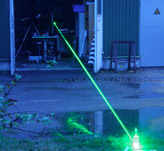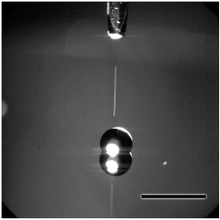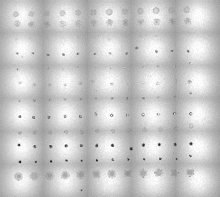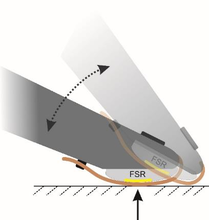Summary
For further descriptions, please see Measurement and Sampling Standards
Description
Standards for Optical Based Standoff Detection

NIST is researching methods for creating explosive threat materials standards relevant to optical detection technologies (e.g. that result in samples with particle morphologies similar to those found in explosive threat devices). This includes both standoff and handheld detection systems including Raman and Infrared spectroscopies.
“Standards for standoff optical-based explosives detection” G Gillen and JR Verkouteren – in Laser-Based Optical Detection of Explosives; Editors, Paul M. Pellegrino, Ellen L. Holthoff, Mikella E. Farrel, CRC Press, (2015).
“Particle Fabrication Using Inkjet Printing onto Hydrophobic Surfaces for Optimization and Calibration of Trace Contraband Detection Sensors”. Gillen G, Najarro M, Wight S, et al. Sensors (Basel). 15(11):29618-29634 (2015).
Precision Deposition of Materials for Trace Detection Standards

NIST utilizes inkjet printing and other novel fluid microdispensing technologies to develop test materials to support field evaluation of new and deployed systems for trace contraband detection. The suite of test materials under development include explosives, narcotics, adulterants, pharmaceutical compounds, and emerging threats. Methods for accurate quantitative analysis of deposited new and emerging threat compounds are being developed for validation of the test materials, including illicit narcotics.
“Performance Metrics Based on Signal Intensity for Ion Mobility Spectrometry – Based Trace Explosives Detectors using Inkjet Printed Materials” Verkouteren, J.R., Lawrence, J., Klouda, G.A., Najarro, M., Grandner, J., Verkouteren, R.M. and York S.J. Analyst,139, 5488-5498 (2014).
“The production of monodisperse explosive particles with piezo-electric inkjet printing technology”. Staymates, M., Fletcher, Verkouteren,J. R, Staymates, J. and Gillen, Greg. Review of Scientific Instruments. 86, 125114. (2015).
“Application of Inkjet Printing Technology to Produce Test Materials of 1,3,5-Trinitro-1,3,5 Triazcyclohexane for Trace Explosive Analysis” Eric Windsor, Marcela Najarro, Anna Bloom, Bruce Benner, Robert Fletcher, Richard Lareau, and Greg Gillen, Analytical Chemistry 82 (20), 8519-8524 (2010).
“Inkjet metrology: high-accuracy mass measurements of microdroplets produced by a drop-on-demand dispenser”. Verkouteren RM, Verkouteren JR Analytical Chemistry. 81(20) (2009).
Anticipatory Standards for Contraband Detection

In a world of rapidly changing and diverse threat materials there is a need to develop timely and relevant test materials and standards. NIST is currently developing standard test materials for illicit narcotics. Recently a pilot program has been started where portions of illicit materials seized by law enforcement and interdiction agencies will be characterized for composition and repurposed as test materials to be disseminated rapidly to front-line forensics labs to aid in detection and identification of emerging threats. This will coincide with the creation of a digital standard, i.e., a mass spectra library, to accompany the new test materials. For narcotics, realistic formulations of test materials that give the correct measurement response may depend on the physical and chemical form of the compound. To address this NIST will explore the role that crystallinity and morphology play in the collection/sampling and analysis of contraband materials.
“Test sample for the spatially resolved quantification of illicit drugs on fingerprints using imaging mass spectrometry”, S Muramoto, TP Forbes, AC van Asten and G Gillen, Analytical chemistry 87 (10), 5444-5450 (2015).
Standard Sampling Metrology

NIST has pioneered the use of controlled metrology measurements to evaluate and optimize the sampling and collection of trace residues, especially explosive materials. The success of explosive trace detection as a primary screening method was, in part, enabled by this research. NIST will expand on this effort to include trace narcotic residues and investigate collection efficiencies. Optimization of trace narcotic residue collection will impact research into the use of trace detection methods to correlate the contents of packages with what is present on the package. Additionally, NIST will continue to develop and implement ASTM Standards related to trace detection.
“A new wipe sampling instrument for measuring the collection efficiency of trace explosives residues” Robinson, E.L., Sisco, E., Staymates, M.E. and Lawrence, J.A.. Anal. Methods, 10, 204-213.(2018).
“Standardized Method for Measuring Collection Efficiency from Wipe-sampling of Trace Explosives”, Jennifer R. Verkouteren, 1 Jeffrey A. Lawrence, 1 Matthew E. Staymates, 1 and Edward SiscoJ. Journal of Visualized Experiments (122), 55484 (2017).
“New particle-based trace explosive test material produced by drop-on-demand inkjet printing for quantitative wipe-sampling studies”, JR Verkouteren, J Lawrence, TM Brewer, and E Sisco - Analytical Methods, 9(23) 3441-3449 (2017).

